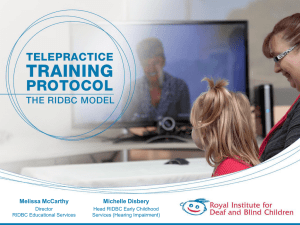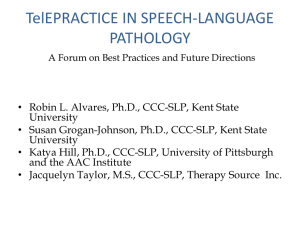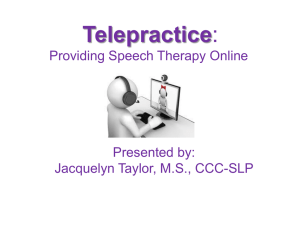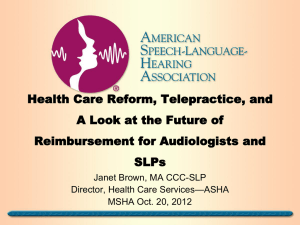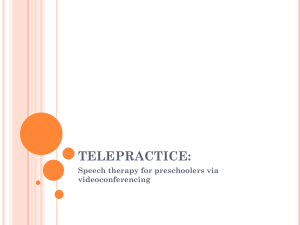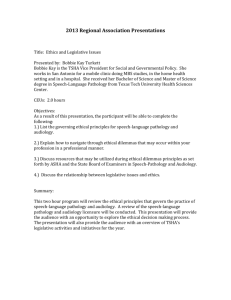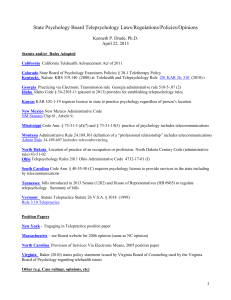Results of a National Survey of Preservice Telepractice Training in Graduate Speech-Language
advertisement
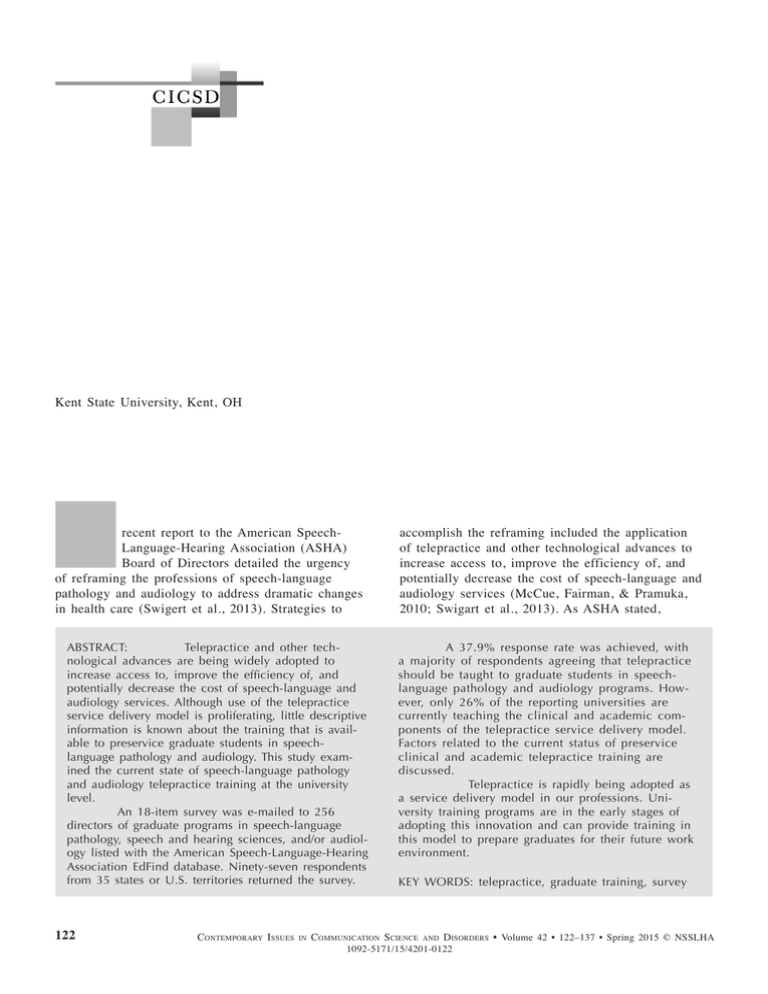
Results of a National Survey of Preservice Telepractice Training in Graduate Speech-Language Pathology and Audiology Programs Sue Grogan-Johnson Rebecca Meehan Kelly McCormick Nicole Miller Kent State University, Kent, OH A recent report to the American SpeechLanguage-Hearing Association (ASHA) Board of Directors detailed the urgency of reframing the professions of speech-language pathology and audiology to address dramatic changes in health care (Swigert et al., 2013). Strategies to ABSTRACT: Purpose: Telepractice and other technological advances are being widely adopted to increase access to, improve the efficiency of, and potentially decrease the cost of speech-language and audiology services. Although use of the telepractice service delivery model is proliferating, little descriptive information is known about the training that is available to preservice graduate students in speechlanguage pathology and audiology. This study examined the current state of speech-language pathology and audiology telepractice training at the university level. Method: An 18-item survey was e-mailed to 256 directors of graduate programs in speech-language pathology, speech and hearing sciences, and/or audiology listed with the American Speech-Language-Hearing Association EdFind database. Ninety-seven respondents from 35 states or U.S. territories returned the survey. 122 accomplish the reframing included the application of telepractice and other technological advances to increase access to, improve the efficiency of, and potentially decrease the cost of speech-language and audiology services (McCue, Fairman, & Pramuka, 2010; Swigart et al., 2013). As ASHA stated, Results: A 37.9% response rate was achieved, with a majority of respondents agreeing that telepractice should be taught to graduate students in speechlanguage pathology and audiology programs. However, only 26% of the reporting universities are currently teaching the clinical and academic components of the telepractice service delivery model. Factors related to the current status of preservice clinical and academic telepractice training are discussed. Conclusion: Telepractice is rapidly being adopted as a service delivery model in our professions. University training programs are in the early stages of adopting this innovation and can provide training in this model to prepare graduates for their future work environment. KEY WORDS: telepractice, graduate training, survey Contemporary Issues in C ommunication Science and Disorders • Volume 42 •42122–137 • Spring Contemporary Issues in Communication Science and D isorders • Volume • 122–137 • Spring2015 2015 © 1092-5171/15/4201-0122 NSSLHA Telepractice is the application of telecommunications technology to the delivery of speech-language pathology and audiology professional services at a distance by linking clinician to client/patient or clinician to clinician for assessment, intervention, and/or consultation. (n.d.a) Many disciplines within health care use telepractice to deliver services, and a variety of terms have been used to describe this service delivery model, including telerehabilitation, telemedicine, and telehealth. In order to avoid the misperception that these services are used in the health care setting only, telepractice is the term used by the professions of speech-language pathology and audiology (ASHA, n.d.a). In fact, live, interactive videoconferencing is used in K–12 schools and colleges (Rice, 2006; Vasquez III & Serianni, 2012) as well as for the provision of school-based speech-language pathology services (Gabel, Grogan-Johnson, Alvares, Beckstein, & Taylor, 2013; Grogan-Johnson, 2010; Grogan-Johnson, Alvares, Rowan, & Creaghead, 2010; Grogan-Johnson et al., 2011, 2013). Telepractice settings for speech-language pathology and audiology include the same settings where traditional in-person services are delivered, including outpatient clinics, client homes, and residential care centers. There are no innate limitations to implementing telepractice as long as the service providers abide by state, institutional, and professional regulations (ASHA, n.d.a). Telepractice services can be provided synchronously (i.e., real-time interactive sessions) and asynchronously (i.e., obtaining data and then forwarding for review). Synchronous services use telecommunications technology to provide a real-time interactive meeting that is similar to that achieved in a physical in-person encounter (ASHA, n.d.a). Synchronous services can include interactions between client and clinician, client and specialist, and/or clinician and specialist. Asynchronous services capture and transmit data or images such as audiologicy test results and video samples from treatment sessions (ASHA, n.d.a). Telemedicine applications have burgeoned in the past few years (Singh, O’Donoghue, & Soon, 2002; Whitten & Love, 2005) as have telepractice applications in speech-language pathology and audiology (Edwards, Stredler-Brown, & Houston, 2012). Along with this rapid implementation, a variety of questions related to this service delivery model have surfaced. One important question that has emerged relates to the training of professionals to use the telepractice service delivery model. In 2002, ASHA conducted a survey of its membership concerning the utilization of telepractice for the delivery of direct services to clients. Results of the survey, completed by 1,667 speech-language pathologists (SLPs) and audiologists, indicated that only 21% of the telepractice users had received explicit education/training in the delivery of services by telepractice. Of those who had received training, 19% had received their training in graduate school, 47% had obtained on-the-job training, 44% had completed continuing education courses, and 17% had used other methods that were not specified (ASHA, 2002). Recommendations arising from the survey included the need for more information on telepractice, and in particular, training for practicing professionals in the delivery of speech-language and audiology services using this methodology. A barrier to the provision of telepractice services reported in the survey was a lack of professional standards (ASHA, 2002). In the years since the initial telepractice survey, ASHA has provided guidance through telepractice policy documents, including a position statement, technical report, and knowledge and skills document (Brown, 2011). In the summer of 2013, these documents were rescinded and were replaced with the ASHA Practice Portal (http://www.asha.org/Practice-Portal/Professional-Issues/Telepractice/), which contains key features from the original guidance documents while maintaining the flexibility to revise and update information in this rapidly changing arena. A culminating point in coordinating access to current information on telepractice came with the formation of the Telepractice Special Interest Group (SIG) in 2010 (Brown, 2011). The SIG has provided a link between telepractioners, ASHA staff, and member experts that allows them to share information, report on best practices, and advocate for the service delivery model (Brown, 2011). Similar requests for training and practice guidelines have been answered by other professions, as evidenced by The Blueprint for Telerehabilitation Guidelines (American Telemedicine Association [ATA], 2010), Practice Guidelines for Mental Health Services (ATA, 2013), and Practice Guidelines for Teledermatology (ATA, 2007). Although training and practice guidelines are becoming available for practicing professionals in the area of telepractice, little is known about what training is available to preservice speech-language pathology and audiology graduate students. We do not know if academia is adequately preparing students to provide services in a future work world that will likely include ever-expanding telepractice service delivery options. The main purposes of this study were to determine (a) the extent to which academic and/or clinical training in a telepractice service delivery model is available in accredited graduate programs in speechlanguage pathology and audiology in the United States and Puerto Rico, (b) the types of telepractice services that are provided in clinical training, (c) Grogan-Johnson et al.: Survey of Preservice Telepractice Training 123 the tools that are used in the delivery of telepractice services, (d) the perceived challenges involved in implementing telepractice training in graduate education, and (e) the graduate students’ knowledge of the telepractice service delivery model. Results of this study could provide useful information to graduate training programs as they revise their curriculum and clinical experiences to stay current with developments in the fields of speechlanguage pathology and audiology. These results could prove useful to undergraduate students when selecting a graduate program. Finally, the results of this study identify needs for developing adequate preservice telepractice training including the critical elements of sound intervention, such as client safety, security, and confidentiality; evidence-based practice (EBP); and adequate data collection. For the initial e-mailing, we contacted 256 program directors in October 2013. In order to reduce nonresponse bias, we sent out reminder e-mails in 2-week intervals during November 2013 to the program directors who had not completed the survey. For follow-up surveys, Qualtrics allowed for refining the list of survey recipients by limiting it to any initial survey recipients who did not complete the initial survey. After the second reminder, clinical directors from nonresponding schools were contacted in December 2013 to seek responses from the clinical director in light of the unresponsiveness of the program director. An e-mail was sent to 160 clinical directors of schools from which a response had not been received from the program director. The clinical directors were sent one reminder e-mail 2 weeks after the initial send. In addition, an online invitation was added to the ASHA Community SIG 18: Telepractice discussion page, requesting universities to participate in the study. Four university employees responded to the post and were invited to participate in the survey. For all responses received, the names were cross-referenced with final data to ensure that the sample included no duplicate participants from a single university. In order to participate in this study, each participant was required to read an informed consent letter that had been approved by the institutional review board at Kent State University. The e-mail to potential participants included the letter of consent along with a link to the survey (see Appendix). By completing and submitting the survey, participants gave their informed consent for study participation. All data were kept confidential. Data collection occurred over 64 days. Method Survey Instrument An 18-item survey (see Appendix) was e-mailed using Qualtrics (www.qualtrics.com), which is a Web-based software program for creating and administering online surveys. Qualtrics software uses skip logic, which allows respondents to skip ahead to a future point in the survey based on specific responses. The survey contained four primary domains of questions pertaining to graduate education in speech-language pathology and/ or audiology, including (a) demographics of the university offering the program, (b) opinions on whether telepractice applications should be taught, (c) current status/prevalence of using telepractice applications, and (d) description and evaluation of how telepractice fits into the current and future curriculum. An initial draft of the survey was critically reviewed by an ASHA senior research associate who is experienced in survey development and research. Results Demographics A total of 102 participants returned the survey. Five respondents initiated but did not complete the survey, resulting in 97 completed surveys and a response rate of 37.9%. Responses were received from 35 states and one U.S. territory (see Table 1). It is interesting to note that the responses received represent all U.S. geographic regions as defined by the U.S. Census Bureau (www.census.gov). Respondents to the survey included 42 (43%) administrators; 35 (36%) clinic directors; and 20 (21%) participants who identified themselves in other categories such as professor, clinical educator, instructor, and/or supervisor. We asked the respondents to identify how many graduate students were currently enrolled in their department. Responses ranged from 21 students to Participants/Procedure We used ASHA’s EdFind database to identify all current graduate programs in communication sciences and disorders in the United States and U.S. territories. Eligible respondents included the program director, clinical director, or representative of an ASHA-accredited graduate program for speech-language pathology, speech and hearing sciences, and/or audiology. Altogether, 256 university programs were invited to participate in the study (N = 256). E-mail addresses for the program directors and clinical directors were obtained from either the university’s website or the university’s page on ASHA’s EdFind database. 124 Contemporary Issues in Communication Science and Disorders • Volume 42 • 122–137 • Spring 2015 Table 1. Survey participation by U.S. Census Bureau regions and divisions. Region Division Urban/urban cluster/rural classification Region 1: Northeast (Total # of respondents = 19 universities) 1: New England CTa MEa MAa NHa RI V 2: Middle Atlantic NJa NYa PAa Urban = 8 Urban cluster = 11 Region 2: Midwest (Total # of respondents = 33 universities) 3: East North Central INa ILa MIa OHa WIa 4: West North Central IA KSa MNa MOa NEa NDa SD Urban = 17 Urban cluster = 16 Region 3: South (Total # of respondents = 33 universities) 5: South Atlantic DE DCa FLa GAa MD NCa SCa VAa WVa 6: East South Central ALa KY MSa TN 7: West South Central ARa LAa OKa TXa Urban = 22 Urban cluster = 11 Region 4: West (Total # of respondents = 11 universities) 8: Mountain AZa CO ID NM MTa UTa NVa WY 9: Pacific AK CAa HI OR WA Urban = 9 Urban cluster = 2 U.S Territory (Total # of respondents = 1 university) Puerto Ricoa a Urban Indicates that university (ies) from that state/territory participated in the survey. 420 students, with a mean of 75 students. In a followup question, we asked the respondents to estimate the number of students who were enrolled in their university. All students, including full- and part-time, graduate and undergraduate status were to be included in the response. Table 2 details the responses from 96 of the 97 respondents; there was one participant who did not respond to this question. Results indicate that more than one third of the respondents (33 responses) were from large universities with a student population greater than 20,000 students. Least represented were universities with less than 2,000 students (two responses). These results may be consistent with speech-language pathology and audiology programs more frequently occurring in larger universities; however, current data are not available to substantiate this hypothesis. respondents (86%) indicated that telepractice applications should be taught to graduate students in speech-language pathology, and 14 respondents (14%) did not think that telepractice applications should be taught. In the area of audiology, 72 responses were recorded; 53 respondents (74%) indicated that telepractice applications should be taught to graduate students in audiology, and 19 respondents (26%) did not think that telepractice applications should be taught. After answering the question, the respondents were invited to add additional comments regarding why or why not telepractice applications should be taught. Table 3 includes examples of the comments received. Opinions on Whether Telepractice Applications Should Be Taught Of the 97 academic programs represented in the sample, there were 92 programs with a university clinic. Of those 92 programs, 24% (n = 23) used live, interactive videoconferencing to deliver speech-language services, whereas only 4% (n = 4) of the programs used this technology to deliver audiology services. One program in the sample used videoconferencing for both speech-language and audiology services. The 92 university programs used a variety of software The first question in the survey asked the respondents to provide their opinion as to whether or not telepractice applications should be included in clinical training for graduate students in speech-language pathology and/or audiology. In the area of speechlanguage pathology, 97 responses were recorded; 83 Status of Graduate Clinical Training in Telepractice Applications Grogan-Johnson et al.: Survey of Preservice Telepractice Training 125 Table 2. Size of university for survey participants (n = 96). Size of university (number of students) Number of responses Respondent percentage <2,000 2,001–5,000 5,001–7,500 7,501–10,000 10,001–12,500 12.501–15,000 15,001–20,000 >20,000 2 9 11 10 8 12 11 33 2.08 9.38 11.46 10.42 8.33 12.50 11.48 34.38 Total 96 100.00 systems to deliver videoconferencing, including Skype (23.0%), WebEx (11.0%), Facetime (7.6%), VSee (7.6%), Adobe Connect (7.6%), Polycom (7.6%), Blackboard (3.8%), Go To Meeting (3.8%), OmniJoin (3.8%), and a regional telehealth system (3.8%). One respondent indicated that he or she had access to videoconferencing equipment through the university but could not identify clients who had access to compatible software systems. Nineteen percent of the respondents (e.g., departmental chairs, clinic directors, and/or designated representatives) did not know what software was used in their telepractice. In a follow-up question, we asked the respondents what percentage of their graduate students received direct clinical training in the use of live, interactive videoconferencing to deliver services. Among programs whose clinics offer these services, 77% (n = 20) reported that a small proportion of graduate students (1%–25%) receive direct clinical training in the use of live, interactive videoconferencing to deliver services in the clinic. Even fewer programs (n = 11) offer training for students through off-site clinical training. There were only four programs that provide training in telepractice to the majority (76%–100%) of their students. Programs offering telepractice serve a range of age groups, with 47% offering services to adults (ages 19–65); 43% offering services to school-age children (ages 6–18), and 27% offering services to both early childhood (ages 0–5) and older adults (age 65+), respectively. Of those providing clinical telepractice services, respondents indicated (by checking all that applied) that a variety of services were offered (see Table 4). Some of the most commonly mentioned were articulation/phonology intervention (22%) and language intervention (20%). Less frequently occurring services included augmentative and alternative assessment (1%), augmentative and alternative intervention (1%), impedance hearing evaluation (1%), and hearing aid evaluation (1%). In addition to live, interactive videoconferencing, programs trained Table 3. Additional comments made by respondents answering Question #1: Do you think telepractice applications should be taught in clinical training for graduate students in speech-language pathology and/or audiology? Quotes from individual participants “I don’t believe that telepractice applications work as well for Audiology, but I think that students should learn about them.” “The curriculum is already full. This can be learned after graduation for those for whom it might apply.” “The client clinician relationship needs the personal touch. I am not certain that the relationship can be as effective using live, interactive videoconferencing alone. Students need the face to face experience. Professionals need the face to face experience first, then perhaps services could continue via videoconferencing.” “I think it is important to give graduate students the skills to identify the type of clients for whom telepractice is appropriate and for whom it is inappropriate.” “Should, no. Could be, yes.” “It’s the reality of the world and becoming more and more used and acceptable in all professions.” “Telepractice will become an even greater aspect of service delivery and should be taught at the preservice level.” “Only in states/regions where this is common practice.” “I don’t know how different the delivery models are.” “Yes, I think that telepractice is a valuable service delivery for underserved populations. In Nevada, we have many rural counties, and countless children who are not served due to distance from the nearest provider. I think there is value in telepractice for audiology for the same reasons.” Note. These are 10 examples of the 17 written comments provided. 126 Contemporary Issues in Communication Science and Disorders • Volume 42 • 122–137 • Spring 2015 Table 4. Services offered among university programs providing clinical telepractice training (n = 34). Service offered % Articulation/phonology intervention Language intervention Expert consultation Parent training Speech/language evaluation Fluency intervention Dialect reduction Voice intervention Pure tone hearing/screening evaluation Hearing aid fitting Resonance/cleft palate and related issues intervention Augmentative and alternative assessment Augmentative and alternative intervention Impedance hearing evaluation Hearing aid evaluation 22 20 11 11 9 9 5 5 2 2 3 1 1 1 1 Note. Respondents were those who indicated that they provided telepractice training. Sixty-three respondents indicated that they do not provide training, and thus the question was nonapplicable. students to use phone, email, and fax as other forms of telecommunication tools to support the provision of direct services to clients/patients. Status of Graduate Academic Training in Telepractice Sixty-six percent (n = 60) of the program respondents did not offer academic preparation in telepractice applications. Of the programs that did offer academic preparation (n = 34), most discussed telepractice applications as part of the curriculum in one or more courses. Only one program reported a separate elective course in telepractice applications. For the respondent programs that did have academic preparation for the use of telepractice applications, most (62%) reported that the majority of their students (76%–100%) received academic preparation in telepractice applications. The respondents were asked to rate how knowledgeable their current graduate students in speech-language pathology and/or audiology were about telepractice before entering graduate school. The majority (79.4%) indicated that their students were not very knowledgeable, with 20.6% indicating that their students were somewhat knowledgeable. To measure an influence of the program, the same question was asked of respondents about their speech-language pathology and/or audiology program graduate students upon completing their graduate degree. More programs described their graduate students as somewhat knowledgeable (50.5%) or very knowledgeable (5.3%). Fewer programs (44.2%) characterized the students as not very knowledgeable in regard to telepractice. These results demonstrate that there is an opportunity to impact the training of graduate students in the telepractice service delivery model. This training would include following the ASHA recommendations for establishing a telepractice service delivery model and complying with EBP, the Health Insurance Portability and Accountability Act of 1996 (HIPAA, 2010), and the Family Educational Rights and Privacy Act (FERPA, 1974) regulations. One program described its students as very knowledgeable after completing the program, saying: Not every grad student has the opportunity to have a telepractice client before they leave, but they ALL have been through a formal training on the equipment and etiquette of telepractice, have had in-class presentations of pros and cons and current examples; have had this content on an exam, and know fellow clinicians who DO have telepractice clients. Plans for Future Inclusion of Telepractice Applications Programs not currently providing clinical preparation in telepractice applications (n = 76) were asked what plans their departments had to include telepractice in the future. Just more than one third (34%) of the group indicated having no plans. Others (39%) indicated that they did have plans but were not aware of when they would be implemented. Fewer programs indicated that they have plans to include telepractice within the year (13%) or within 3 years (7%). Written comments provided for including telepractice applications in the future are provided in Table 5. For programs that were not including telepractice in their graduate clinical training, respondents were asked to provide reasons. Respondents could check all that applied and/or add other comments. The most commonly reported reasons were a lack of funding/resources (31%), lack of technology (25%), no faculty to provide training (24%), uncertainty about regulations for providing telepractice (18%), unaware of research or a belief that there is insufficient research to support this approach (19%), unsure how to use needed technology (7%), and not interested in the service delivery model (8%). Thirty-six percent of respondents indicated that there were other reasons. Other reasons articulated in open-ended comments included concerns over funding or reimbursement as well as uncertainty of laws and regulations related to privacy using telepractice. Other comments Grogan-Johnson et al.: Survey of Preservice Telepractice Training 127 interest to study one of the areas of concern associated with this model: the availability of preservice training. We surveyed university training programs to determine the extent to which a telepractice service delivery model was being used in university clinics and to determine the availability of academic and clinical telepractice instruction. A 2002 survey conducted by ASHA revealed that fewer than 21% of respondents had received explicit instruction in how to deliver speech-language or audiology services using a telepractice service delivery model. Of those who had received training, the greatest number (47%) reported receiving on-thejob training as compared with 19% who had received their training in graduate school (ASHA, 2002). This result exemplifies the need to establish telepractice training protocols that can be implemented by trained and experienced instructors. Although training (albeit on-the-job training) has been reported for practicing professionals in the area of telepractice, little is known about what training is available to preservice speech-language pathology and audiology graduate students. This survey is the first attempt to gather this information. Although exploratory, the results provide a description of the current status of telepractice training in graduate programs in speech-language pathology and audiology in the United States and Puerto Rico. The domains included in the survey are not exhaustive, but they establish a foundation for future research on preservice telepractice training. This study surveyed program and clinic directors to determine (a) the extent to which academic and/or clinical training in a telepractice service delivery model is available in accredited graduate programs in speech-language pathology and audiology in the United States and Puerto Rico, (b) the types of telepractice services that are provided in clinical training, (c) the tools that are used in the delivery of telepractice services, (d) the perceived challenges involved in implementing telepractice training in graduate education, and (e) the graduate students’ knowledge of the telepractice service delivery model. Findings from this study suggest that clinical and academic training of the telepractice service delivery model are only in the beginning stages of adoption. We asked participants about their inclusion of clinical and academic training of the telepractice service delivery model. A modest 24% of responding speech-language pathology graduate programs and only 4% of audiology programs reported using live, interactive videoconferencing for the delivery of services. Of those programs that provide telepractice services, the greatest number (46%) are housed in universities of more than 20,000 students (Table Table 5. Comments on university programs’ plans for including telepractice applications in the future. We have been approved to use “Jabber” [software] as a tool, but we do not have an appropriate referral at this time. It will likely be incorporated as a topic first in our clinical courses. Unsure if or when we will address this. Needs to be discussed within the curriculum committee. Currently, in our state, Medicaid will not reimburse for services provided via telepractice. This is a huge factor in why we do not currently offer services in this manner. It does not, however, excuse educating graduate students in telepractice guidelines. Maybe. It depends on the curriculum and the number of credits our students must take. Also, we need to look and see if information on telepractice can be infused into another course…so it is on the radar screen. We provide an “introduction” now but plan to add a more robust academic experience in the future. We plan to begin with fluency. We were all set to go with a specific client—until we discovered she had moved out of state and our clinician was not licensed in that location. It is not currently a topic of discussion. Telepractice will be included in class sections as chapters. highlighted departmental struggles between academic and clinical staff, whose philosophies on curriculum and how best to prepare graduate students for the job market differed substantially. Discussion Health care is experiencing enormous growth in the utilization of telepractice applications to deliver services in spite of the paucity of available evidence concerning the associated cost effectiveness and quality of care for services that are delivered through this method as well as concerns related to quality control, consumer protection and security, reimbursement, and standards of training and care (Adler-Milstein, Kvedar, & Bates, 2014; Bashshur, 2004). Although telehealth applications have been used in some areas of health care for many years, its utilization in the fields of speech-language pathology and audiology is more recent. With the expanding implementation of the telepractice service delivery model in the fields of speech-language pathology and audiology, it was of 128 Contemporary Issues in Communication Science and Disorders • Volume 42 • 122–137 • Spring 2015 6). In addition, 77% of those programs indicated that direct clinical instruction in this service delivery model was restricted to less than 25% of the graduate students, suggesting limited availability for clinical preparation in the use of this service delivery model. Geographic Distribution of Programs To better understand the nature of university-based telepractice services, we examined the data to determine the location of the programs that provide training. Of particular interest was identifying whether or not the telepractice service delivery model was being taught in sections of the country with the largest frontier areas. Frontier areas are rural areas that are sparsely populated and typically are isolated from health care and other services (National Center for Frontier Communities, 2012b) and would therefore benefit from the provision of services by telepractice. Twenty-six different universities reported providing telepractice services for speech-language pathology and/or audiology. Of those universities, four were located in the northeastern region of the United States, 15 in the midwest region, six in the southern region of the country, and one in the western region. The most recent data on frontier areas in the United States reveals that the largest concentrations exist in the midwest (including the western regions of Kansas, Nebraska, and Oklahoma, as well as most of North and South Dakota), west (including Montana, Wyoming, Colorado, New Mexico, Nevada, Idaho, and portions of Oregon, Washington, California, and Arizona), and the entire state of Alaska. Significantly smaller frontier areas can be found in the southern and northeast regions (National Center for Frontier Communities, 2012a). Of the universities represented in this survey, only two (8%) housed within frontierdesignated areas (Montana and Nevada) reported providing telepractice services. The majority of reporting universities are providing telepractice services in nonfrontier regions. This was an unexpected result given the impetus to increase services for residents in frontier regions and the potential for telepractice to provide this increased access. To better understand this result, we next reviewed data related to the supply and demand for SLPs in various regions of the country regardless of their frontier designation. Although a shortage of SLPs exists throughout the country (Squires, 2013), rural and urban areas in the states of California, Florida, Illinois, New York, and Texas (which are not typically included in frontier designations) reportedly have the greatest unmet needs for SLPs in all professional practice areas (Wolfgang, 2011). We reviewed university responses from each of those states to determine the implementation of preservice telepractice training. The results by state for reporting universities revealed that 0/6 in California, 0/4 in Florida, 1/5 in Illinois, 1/9 in New York, and 2/7 in Texas were providing preservice telepractice training. It is likely that this shortage of SLPs will continue because projections from the U.S. Bureau of Labor and Statistics (BLS) predict an increased employment rate of 19% for SLPs during the period 2012–2022. (BLS, 2014). This increased rate of employment is faster than average for all occupations tracked by the BLS (2014). Based on the results available from this survey, very few university programs are providing preservice training in regions of the country where the most critical shortage of SLP services exist. Variability within state regulations related to the provision of speech-language pathology and audiology services via telepractice has also impacted implementation of the service delivery model. Currently, only 18 states and the District of Columbia have governing laws, regulations, definitions, and/or policies related to telepractice use for SLPs and audiologists (ASHA, n.d.b). Variability exists in the types of services (i.e., intervention but not evaluations can be conducted by telepractice), the types of telecommunications technology (i.e., only synchronous communications are permitted), and the consumer safeguards Table 6. The size of the universities providing preservice telepractice instruction (n = 26). Size of university (in thousands) <2000 2,001–5000 5,001–7,500 7,501–10,000 10,001–12,500 12,501–15,000 15,001–20,000 >20,000 Number of reporting universities that provide telepractice services 0 2 3 3 2 4 0 12 Percentage of respondents 0.0 7.7 11.5 11.5 7.7 15.4 0.0 46.2 Grogan-Johnson et al.: Survey of Preservice Telepractice Training 129 that are required by individual states. This variability will likely increase as more states begin to adopt telepractice regulations. district rather than by the health care payer (Brown et al., 2010). In addition, some state school Medicaid programs are reimbursing for speech-language telepractice services that are delivered to students in the public school setting. In general, all state Medicaid programs reimburse for some health care services that are delivered to eligible children and adults, but speech-language and audiology telepractice services are not consistently reimbursed across all states (ATA, n.d.). Medicare does not reimburse for speechlanguage and audiology services delivered by telepractice applications. Clients who are 65 years of age or older with Medicare coverage need additional supplemental insurance and/or must pay out of pocket for speech-language and audiology telepractice services. Currently, 20 states and the District of Columbia require private insurers to cover services that are provided through telepractice the same as they would cover the same service provided in person (ATA, n.d.). Comparing the current reimbursement circumstances to the reported populations served in university training programs for telepractice revealed that services are most frequently provided to adults ages 19–65 years (47%) and school-age children ages 6–18 years (43%), which corresponds favorably with current payer sources through a school district, Medicaid programming, or private-pay insurer. Age groups that are less likely to receive services through telepractice in the university are young children, ages birth–5 years (27%) and older adults who are 65 years old or older (27%). These findings are consistent with actual practice as telepractice services in early intervention have lagged behind other disciplines (Olsen, Fiechtl, & Rule, 2012). Current telepractice reimbursement sources are limited for older adults and may constrain practice in delivering services to this age group. An alternative explanation may relate to the perception that older adults may not be able to use technology adequately or may not be willing to participate in such a novel service delivery model. However, in a review of research related to the provision of services to adults with neurological communication impairments, Theodoros (2011) reported high levels of patient satisfaction and improvements in communicative functioning using various telepractice service delivery methods. Critical to improved reimbursement for telepractice services will be establishing the cost effectiveness of the delivery model and scientific evidence of its benefit (Heinzelmann, Lugn, & Kvedar, 2005). Personnel shortages and increased costs throughout the health care system, including speech-language pathology and audiology, are factors driving the adoption of telepractice services. And, although largescale telepractice deployment has occurred within the Age Groups of Clients Served A variety of telepractice services delivered through university training programs were provided most frequently to adults (ages 19–65) and school-age children (ages 6–18) and less frequently to young children (ages 0–5) and older adults (ages 65+). In order to analyze the nature of the services provided in the university training programs, we first compared the age groups served and the types of services provided by the university training programs to those reportedly occurring in clinical telepractice service delivery. Results suggest that the age groups served and the types of services provided in the university training programs are similar to the services reported in clinical telepractice (Grogan-Johnson et al., 2013; Reynolds, Vick, & Haak, 2009; Theodoros, 2011). These include school-age children and adults with speech, language, voice, and fluency disorders as well as children with language impairment secondary to autism and adults with communication impairment secondary to traumatic brain injury or cerebral vascular accident. Less frequently, there are reports of parent training and intervention with young children with hearing loss. While examining the age groups served by telepractice, we did not survey the participants on their process for determining candidacy for services delivered by telepractice. Because speech-language intervention services are centered on the unique needs of individual clients, a telepractice service delivery model may not be appropriate for all clients and all circumstances. Therefore, candidacy for receiving telepractice services should be considered before initiating services (ASHA, n.d.a). Additional research is needed to establish candidacy characteristics as well as types of disorders that are best served using the telepractice service delivery model. Reimbursement Next, we attempted to discern the relationship of reimbursement to the types of services and/or the age groups included in university training of speechlanguage pathology and audiology telepractice. A lack of reimbursement is one of the most significant obstacles to the advancement of telepractice in the clinical setting (Brown, Brannon, & Romanow, 2010). Currently, the provision of speech-language and audiology telepractice services to school-age children is expanding because the services are paid by the school 130 Contemporary Issues in Communication Science and Disorders • Volume 42 • 122–137 • Spring 2015 Veterans Administration and statewide networks with the United States, clearly established EBPs and return on investment are yet to be sufficiently established (Heinzelmann et al., 2005). Technology In addition to populations and types of services provided, the survey respondents were asked to provide information on the types of software and/or videoconferencing software they were using. A wide variety of responses was recorded, with approximately 26% of respondents indicating that they used Skype (www. skype.com) for videoconferencing sessions. It should be noted that Skype and other similar videoconferencing platforms are reportedly being used by a number of health care professions to deliver services. An important consideration in the selection of videoconferencing equipment is the necessity to comply with HIPAA and FERPA (20 U.S.C. § 1232g; 34 CFR Part 99, 1974) regulations in regard to client privacy and confidentiality. The topics of software selection, regulatory compliance, and the adequacy of Skype and other similar videoconferencing platforms are frequently discussed and debated in a variety of disciplines that are providing services by telepractice (CloudVisit Telemedicine, 2014; Pramuka & van Roosmalen, 2009; Watzlaf, Moeini, & Firouzan, 2010). In light of these challenges, it would be helpful to the professions to establish technology compliance criteria in order to ensure client safety and confidentiality. Continuing education and training will help to ensure HIPAA compliance as this service delivery model expands. Barriers to Adopting Telepractice in Graduate Programs An essential component of this study was to ascertain the current state of preservice telepractice instruction in graduate training programs in speech-language pathology and audiology. Equally compelling was to understand respondents’ perceived or known barriers to implementing telepractice training. This information was gleaned from two of the survey questions. Survey question #1 asked “Do you think telepractice applications (service delivery via live, interactive videoconferencing) should be taught in clinical training for graduate students in speech-language pathology and/or audiology?” A clear majority of respondents indicated that telepractice applications should be taught in speech-language pathology (86%) and audiology (74%). In spite of recognizing a need for the instruction, only 26% of the programs (both speech-language pathology and audiology) responding to the survey were currently providing telepractice instruction. Programs not currently providing clinical preparation were asked a follow-up question regarding their plans to include such instruction in the future. Thirty-six percent of the respondents indicated no plans to incorporate telepractice training, 38% indicated that planning had been completed but they did not have a timeline for implementation, and 5% were uncertain of plans to incorporate telepractice training. A smaller number of respondents (16%) indicated that telepractice would be implemented within a year, and 5% indicated that instruction would start within 3 years. The most commonly reported reasons for not implementing telepractice instruction related to a lack of funding, lack of technology, and lack of trained faculty to provide the instruction. Less common were concerns about adequate knowledge of regulations related to the service delivery model, insufficient research to support the approach, reimbursement for telepractice services, and ability to maintain client privacy. These results exemplify the importance of establishing training, competency development, and perhaps certification programs to ensure that personnel have the appropriate training and expertise required to conduct services through a telepractice service delivery model (Brennen, Holtz, Chumbler, Kobb, & Rabinowitz, 2008). Other influences on the slow rate of adoption of telepractice include business models that are at the early stages of development for making it feasible for patients to be seen using the telepractice model. For example, one participant program reported having a rather sophisticated software system for telepractice, but none of its clients had a compatible system to communicate with the software system. Moreover, as academic organizations have complex and interdependent departments, policies, and regulations, there can be many practical issues preventing the exploration of innovation. For example, Spalter-Roth, Fortenberry, and Lovitts (2007) noted that a curricular innovation that is implemented in modules of a course can be more rapidly adopted than a more substantive curricular addition, as may be required with telepractice. Thus, the way in which telepractice is incorporated into preservice training for speech-language pathology and audiology graduate programs will influence the speed with which the innovation is used by the program. Study Limitations This study offers insights into the current state of preservice training in the telepractice service delivery model for the fields of speech-language pathology Grogan-Johnson et al.: Survey of Preservice Telepractice Training 131 and audiology. However, there are several limitations to this study. First, although the representativeness of the respondents (e.g., demographics, size of university) appears to be adequate, it would be beneficial to have a response rate higher than the achieved 37.9%. In relation to the provision of telepractice services, future studies should attempt to obtain a thorough description of the services provided, including if the services are provided across state lines or internationally, and if the services are provided to clients who lack accessibility or some other determining factor. Because the sample for this study was drawn from ASHA-accredited programs, the assumption was made that the graduate training programs had knowledge of and were compliant with HIPAA and FERPA guidelines related to the provision of telepractice services. Future studies should determine participants’ level of understanding of related regulations. Also of note was the high positive response rate (86%) related to the need for telepractice applications to be taught in the university. This result may reflect a response bias suggesting that people with a particular interest in telepractice completed the survey. However, the low rate of telepractice training implementation mitigates this concern. Finally, telepractice is a relatively new service delivery model for the professions of speech-language pathology and audiology. Although the majority of speech-language and audiology services continue to be provided through a traditional in-person service delivery model, telepractice is gaining acceptance in the United States and Puerto Rico. Currently, we do not know what percentage of total speech-language and audiology services are provided by telepractice each year. This information may help us better assess adoption of the service delivery model and integration into the current academic and clinical curriculum in graduate training programs. a majority of respondents agreed that telepractice applications should be taught in graduate programs, only 26% of the programs responding to the survey were currently providing direct telepractice instruction. Telepractice applications were more frequently being taught in speech-language pathology programs as compared to audiology graduate programs. A majority of respondents (59%) indicated the intention to add telepractice instruction into graduate training, whereas 36% reported no current plans to include academic or clinical instruction in a telepractice service delivery model. Telepractice services delivered through university training programs were provided to clients of a variety of age ranges and communication disorders and these clients were similar to the clients receiving telepractice services reported in professional publications. Health care services provided through telehealth applications are a noteworthy and rapidly growing area in the United States (Wilson, 2002). In spite of uncertainties with legal, regulatory, and ethical requirements, it is likely that technological advancements will continue to propel the implementation of the telepractice service delivery model. The opportunities for greater access to services with improved efficiency and cost savings may establish this service delivery model for future SLPs and audiologists. In order to adequately prepare students for a future work environment that includes a telepractice service delivery model, graduate training programs should consider incorporating clinical and academic training in the telepractice service delivery model. Future directions for research include investigating a curriculum for academic and clinical telepractice instruction; identifying the key aspects of effective clinical instruction in a telepractice service delivery model; determining how to translate clinical instruction from an in-person service delivery model to a live, interactive videoconferencing model; establishing minimal connectivity (i.e., bandwidth) standards for adequate videoconferencing; identifying characteristics of clients who are and are not candidates for a telepractice service delivery model; continuous risk management procedures for client safety and security during live, interactive videoconferencing; and EBPs associated with a telepractice service delivery model. Conclusion The primary goals of this study were to determine (a) the extent to which academic and/or clinical training in a telepractice service delivery model is available in accredited graduate programs in speechlanguage pathology and audiology in the United States and Puerto Rico, (b) the types of telepractice services that are provided in clinical training, (c) the tools that are used in the delivery of telepractice services, (d) the perceived challenges involved in implementing telepractice training in graduate education, and (e) the graduate students’ knowledge of the telepractice service delivery model. Although 132 Contemporary Issues in Communication Science Acknowledgment This research was supported by a 2013 Advancing Academic-Research Career award from the American Speech-Language-Hearing Association. and Disorders • Volume 42 • 122–137 • Spring 2015 References Adler-Milstein, J., Kvedar, J., & Bates, D. (2014). Telehealth among US hospitals: Several factors, including state reimbursement and licensure policies, influence adoption. Health Affairs, 33(2), 207–215. American Speech-Language-Hearing Association. (n.d.a). Practice portal: Professional issues—telepractice/overview. Retrieved from www.asha.org/PRPSpecificTopic. aspx?folderid=8589934956&section=Overview American Speech-Language-Hearing Association. (n.d.b). State telepractice requirements. Retrieved from www. asha.org/Advocacy/state/State-Telepractice-Requirements/ American Speech-Language-Hearing Association. (2002). Survey report on telepractice use among audiologists and speech-language pathologists. Retrieved from www.asha. org/upladedFiles/practice/telepractice/SurveyofTelepractice.pdf American Telemedicine Association. (2007). Practice guidelines for teledermatology. Retrieved from www. americantelemed.org/resources/standards/ata-standardsguidelines/practice-guidelines-for-teledermatology#. U069p1VdW7w American Telemedicine Association. (2010). A blueprint for telerehabilitation guidelines. Retrieved from www. americantelemed.org/i4a/pages/index.cfm?pageid=3311 American Telemedicine Association. (2013). Practice guidelines for video-based online mental health services. Retrieved from www.americantelemed.org/docs/defaultsource/standards/practice-guidelines-for-video-based-online-mental-health-services.pdf?sfvrsn=6 American Telemedicine Association. (n.d.). Telemedicine frequently asked questions. Retrieved from www.americantelemed.org/about-telemedicine/faqs#.U5ibafmwJcR Bashshur, R. (2004). Chapter 1: Telemedicine and health care. Telemedicine Journal and E-Health, 8(1), 5–12. doi:10.1089/15305620252933365 Brennen, D., Holtz, B., Chumbler, N., Kobb, R., & Rabinowitz, T. (2008). Visioning technology for the future of telehealth. Telemedicine Journal and e-Health, 14(8), 982–985. Brown, J. (2011). ASHA and the evolution of telepractice. SIG 18 Perspectives on Telepractice, 1, 4–9. doi:10.1044. tele1.1.4 Brown, J., Brannon, J., & Romanow, K. (2010). Reimbursement for telespeech. Perspectives on Voice and Voice Disorders, 20(1), 16–21. Bureau of Labor Statistics, U.S. Department of Labor. (2014). Occupational outlook handbook, 2014–15 edition, speech-language pathologists. Retrieved from www.bls. gov/ooh/healrthcare/speech-language-pathologists.htm CloudVisit Telemedicine. (2014). Skype with patients? HIPAA says “no go.” Retrieved from http://finance,yahoo. com/news/skype-patients-hipaa-says-no=175333438.html Edwards, M., Stredler-Brown, A., & Houston, K. (2012). Expanding use of telepractice in speech-language pathology and audiology. Volta Review, 112(3), 227–242. Family Educational Rights and Privacy Act of 1974, 20 U.S.C. § 1232g (1974). Retrieved from http://www2. ed.gov/policy/gen/guid/fpco/ferpa/index.html Gabel, R., Grogan-Johnson, S., Alvares, R., Beckstein, L., & Taylor, J. (2013). A field study of telepractice for school intervention using the ASHA NOMS K–12 database. Communication Disorders Quarterly, 35, 42–51. doi:10.1177/1525740113503035 Grogan-Johnson, S. (2010). A pilot telespeech project: Providing speech-language services to Ohio’s rural schools. SpeechPathology.com, Article 3810. Retrieved from www.speechpathology.com/articles/article_detail. asp?article_id=393 Grogan-Johnson, S., Alvares, R., Rowan, L., & Creaghead, N. (2010). A pilot study comparing the effectiveness of speech language therapy provided by telemedicine with conventional on-site therapy. Journal of Telemedicine and Telecare, 16(3), 134–139. Grogan-Johnson, S., Gabel, R., Taylor, J., Rowan, L., Alvares, R., & Schenker, J. (2011). A pilot exploration of speech sound disorder intervention delivered by telehealth to school-age children. International Journal of Telerehabilitation, 3(1), 31–41. doi:10.5195/ijt.2011.6064 Grogan-Johnson, S., Schmidt, A. M., Schenker, J., Alvares, R., Rowan, L., & Taylor, J. (2013). A comparison of speech sound intervention delivered by telepractice and side-by-side service delivery models. Communication Disorders Quarterly, 34, 210–220. doi:10.1177/15257401 13484965 Health Insurance Portability and Accountability Act of 1996, 42 U.S.C. § 1320d-9 (2010). Retrieved from www. hhs.gov/ocr/privacy/ Heinzelmann, P., Lugn, N., & Kvedar, J. (2005). Telemedicine in the future. Journal of Telemedicine and Telecare, 11(8), 384–390. McCue, M., Fairman, A., & Pramuka, M. (2010). Enhancing quality of life through telerehabilitation. Physical Medicine and Rehabilitation Clinics of North America, 21, 195–205 doi:10.1016/j.pmr.2009.07.005 National Center for Frontier Communities. (2012a). Frontier designated areas 2010: Revised June 26, 2012. Retrieved from www.frontierus.org/documents/maps/2010_ Frontier_Counties_Map_fin062612.pdf National Center for Frontier Communities. (2012b). The meaning of frontier. Retrieved from www.frontierus. org/defining.php Olsen, S., Fiechtl, B., & Rule, S. (2012). An evaluation of virtual home visits in early intervention: Feasibility of “virtual intervention.” The Volta Review, 112(3), 267–281. Pramuka, M., & van Roosmalen, L. (2009). Telerehabilitation technologies: Accessibility and usability. International Journal of Telerehabilitation, 1(1), 85–97. Reynolds, A., Vick, J., & Haak, N. (2009). Telehealth applications in speech-language pathology: A modified narrative review. Journal of Telemedicine & Telecare, 15(6), 310–316. doi:10.1258/jtt2009.081215 Grogan-Johnson et al.: Survey of Preservice Telepractice Training 133 Rice, K. (2006). A comprehensive look at distance education in the K–12 context. Journal of Research on Technology in Education, 38(4), 425–448. Vasquez III, E., & Serianni, B. (2012). Research and practice in distance education for K–12 students with disabilities. Rural Special Education Quarterly, 31(4), 33–42. Singh, G., O’Donoghue, J., & Soon, C. (2002). Telemedicine: Issues and implications. Technology & Health Care, 10(1), 1–10. Watzlaf, V., Moeini, S., & Firouzan, P. (2010). VOIP for telerehabilitation: A risk analysis for privacy, security and HIPAA compliance. International Journal of Telerehabilitation, 2(2), 3–14. Spalter-Roth, R., Fortenberry, N., & Lovitts, B. (2007). The acceptance and diffusion of innovation: A cross-disciplinary approach to instructional and curricular change in engineering. Washington, DC: American Sociological Association. Whitten, P., & Love, B. (2005). Patient and provider satisfaction with the use of telemedicine: Overview and rationale for cautious enthusiasm. Journal of Postgraduate Medicine, 51(4), 294–300. Squires, K. (2013). Addressing the shortage of speechlanguage pathologists in school settings. Journal of the American Academy of Special Education Professionals. Retrieved from https://www.naset.org/3702.0.html Wilson, M. (2002). The future of telemedicine. Studies in Health Technology and Informatics, 80, 129–136. Wolfgang, K. (2011). Job outlook: Strong demand: A promise of growth, high earnings, and endless opportunities. Trends in Speech-Language Pathology and Audiology Special Employment Guide. Retrieved from http://speechlanguage-pathology.advanceweb.com/Web-Extras/OnlineExtras/Special-Employment-Guide.aspx Swigert, N., Abrams, H., Cornett, B., Green, C., Kummer, A., McNamara, T.,… McNeilly, L. (2013). Final report: Reframing the professions of speech-language pathology and audiology. Retrieved from www.asha. org/uploadedFiles/Report-Ad-Hoc-Committee-on-Reframing-the-Professions.pdf#search=%22asha%22 Theodoros, D. (2011). Telepractice in speech-language pathology: The evidence, the challenges, and the future. SIG 18 Perspectives on Telepractice, 1, 10–21. doi:10.1044/tele1.1.10 134 Contemporary Issues in Communication Science Contact author: Sue Grogan-Johnson, Speech & Hearing Clinic, A104 CPA, Kent State University, Kent, OH 44242-0001. E-mail: sgrogan1@kent.edu and Disorders • Volume 42 • 122–137 • Spring 2015 Appendix (p. 1 of 3). Cover Letter and Survey Questions Dear Faculty Member, We are conducting a survey to investigate preservice telepractice training for graduate students in speechlanguage pathology and/or audiology. Telepractice is a service delivery model in which speech-language pathology and audiology professional services are provided to distant clients/patients through the use of telecommunications technology. You are invited to participate in this survey because your university was identified as having a graduate program in speech-language pathology and/or audiology on the American Speech-Language-Hearing Association website (www.asha.org). Knowing about the integration of telepractice applications into training programs may help students and university programs better prepare for future service delivery of speech-language pathology and audiology services. We value your input and hope that you will consider participating in this survey. If you are willing to participate, please read the following consent form and then click on the link to the survey. By selecting the link to the survey or copying and pasting the survey web address into your web browser, you will indicate your willingness to participate. We anticipate that it will take 10 minutes to complete this short survey. The survey will be open for 6 weeks. Please complete the survey at your earliest convenience. We appreciate your help with this research, and please do not hesitate to contact us with questions. Thank you, Sue Grogan-Johnson, Ph.D., CCC/SLP Rebecca A. Meehan, Ph.D. Survey Questions The purpose of this survey is to investigate the knowledge and use of telepractice in the clinical and academic training of graduate students studying speech-language pathology and audiology. In this survey, the term “telepractice” refers to the provision of professional speech-language pathology and audiology services to distant clients/patients using telecommunications technology. Telecommunications technology refers to any technology that permits communication at a distance (e.g., telephone, Internet, radio). There are a variety of telecommunication applications that could be identified under the telepractice definition. These first survey questions relate specifically to the use of live, interactive videoconferencing as a means of providing professional services to distant clients/patients. Q1: Do you think telepractice applications (service delivery via live, interactive videoconferencing) should be taught in clinical training for graduate students in speech-language pathology and/or audiology? Check all that apply. A. Speech-Language Pathology: Yes or No B. Audiology: Yes or No Comments: Q2: Are you currently using live, interactive videoconferencing to deliver services in your university clinic? Check all that apply. A. Yes in our speech pathology clinic B. Yes in our audiology clinic C. No D. No, we don’t have a university clinic E. If you are providing speech-language or audiology services by live, interactive videoconferencing, please tell us what system/software that you using: ______________________________________ Q3: Approximately what percent of your graduate students receive direct clinical training in the use of live, interactive videoconferencing to deliver services in your university clinic? A. 0% B. 1–25% C. 26–50% D. 51–75% E. 76–100% F. N/A (no clinic) Q4: Approximately what percent of your graduate students receive direct clinical training in the use of live, interactive videoconferencing to deliver services through an off-site training experience? A. 0% B. 1–25% C. 26–50% D. 51–75% E. 76–100% F. N/A (we have no off-site training experiences) Grogan-Johnson et al.: Survey of Preservice Telepractice Training 135 Appendix (p. 2 of 3). Cover Letter and Survey Questions Q5: If you are providing clinical telepractice training, what age groups are being served? Check all that apply. A. Early Childhood 0–5 years B. School-age 6–18 years C. Adult 19–65 years D. Older Adult Greater than 65 years E. NA, not providing training Q6: If you are providing clinical telepractice training, what types of services are provided? Check all that apply. A. Articulation/phonology intervention B. Language intervention C. Fluency intervention D. AAC intervention E. Voice intervention F. Resonance/Cleft Palate & related issues Intervention G. Dialect reduction H. Speech/Language Evaluation I. AAC assessment J. Pure Tone Hearing Screening or Evaluation K. Impedance Hearing Evaluation L. Hearing Aid Evaluation M. Hearing Aid Fitting N. Expert Consultation O. Parent Training P. NA, not providing training Q9: Approximately what percentage of your graduate students receive academic preparation in telepractice applications? A. 0% B. 1–25% C. 26–50% D. 51–75% E. 76–100% Now please answer these final questions related to the preservice telepractice training for graduate students in speech-language pathology and audiology. Q10:If your program is not currently providing clinical preparation in telepractice applications, does your department have plans to include telepractice applications in the future? A. No B. Yes, within a year C. Yes, within 3 years D. Yes, not sure when E. Other F. N/A. We provide this preparation Comments: Q11: If you are not currently including telepractice in your graduate clinical training, please indicate why not. Check all that apply. A. Lack of technology B. Lack of funding/resources C. Unsure of regulations regarding the provision of telepractice services D. Unsure how to use technology E. Not aware of research supporting this approach F. Belief that there is insufficient research to support this approach G. No faculty to provide the training H. Not interested I. Other ____________________ Comments: In addition to live, interactive videoconferencing, there are other telecommunication applications that can be identified under the telepractice definition. Please answer this question related to the use of other telecommunication technologies in preservice preparation. Q7: Which of the following telecommunication tools do you train students to use in providing direct services to clients/patients? Check all that apply. A. Telephone B. Email C. Fax D. Mail E. Other: ________________________________ Q12:In your opinion, how knowledgeable are the current graduate students in your university’s speech-language pathology and/or audiology program about telepractice prior to entry into graduate school? A. Not very knowledgeable B. Somewhat knowledgeable C. Very knowledgeable Comments: Now please answer these questions related to academic preparation for the use of telepractice services. Q8: Do you offer academic preparation in telepractice applications? Check all that apply. A. No B. Yes, We have an elective course C. Yes, We discuss telepractice applications as part of the curriculum in one or more courses. D. Other Comments: 136 Contemporary Issues in Communication Science Q13:In your opinion, how knowledgeable are graduate students in your university’s speech-language pathology and/or audiology program about telepractice upon completing their graduate degree? A. Not very knowledgeable B. Somewhat knowledgeable C. Very knowledgeable Comments: and Disorders • Volume 42 • 122–137 • Spring 2015 Appendix (p. 3 of 3). Cover Letter and Survey Questions Q14:How many graduate students are enrolled in your department? Q15:Approximately how many students (all students including full-, and part-time, undergraduate and graduate) are enrolled in your university? A. <2,000 B. 2,001–5,000 C. 5,001–7,500 D. 7,501–10,000 E. 10,001–12,500 F. 12,501–15,000 G. 15,001–20,000 H. >20,000 Q16:In what state is your university located? (drop down of states) Q17:Because we are interested in understanding where concentrations of telepractice training tend to occur (e.g., urban, suburban, rural), we would like to know the zip code of your university/institution. What is your zip code? Q18: What is your primary role at the university? A. Administrator B. Clinical Director C. Other: Thank you for completing this survey! Grogan-Johnson et al.: Survey of Preservice Telepractice Training 137
